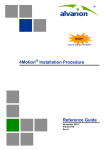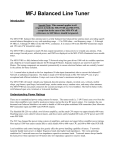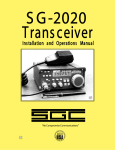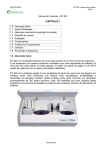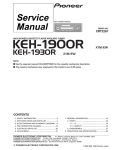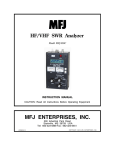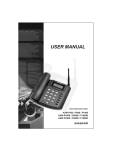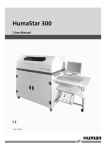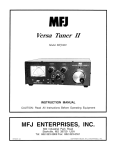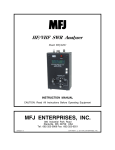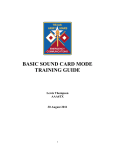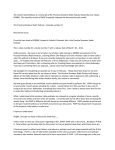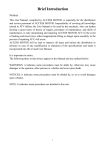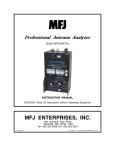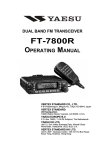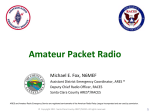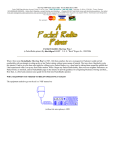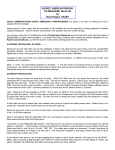Download Introduction to two way radio communications
Transcript
Introduction to two way radio communications By Karen Johansen – WB5GEO In the world of communications and 2-way radio's there are many ways to build a complete communications system and network for your family and prepper group without spending a great deal of money in the process. Even the price of Amateur radios have dropped over the years as the technology has advanced, not that long ago a 2 channel, VHF mobile radio would have cost $1500 and taken up most of your trunk to mount it. Today, a VHF mobile with all the bells and whistles is not must bigger that a old CB set and cost about $140 new in the box. Can you still spend a thousand dollars for a good Amateur radio? Well, yes. But it will cover almost every band and mode assigned to Amateur operators and has a 100 watt power output. Below are links to wikipedia pages about each service that will give a starting point. If you have any questions, feel free to e-mail me and I will do my best to answer your communications questions. Abbreviation Service Name License Service FRS Family Radio Service No license required FRS radio unlimited to their range as the Federal government has set the maximum power output of a 250 milowatts which translates into a range of about one mile unimpeded by terrain, buildings or other obstructions. GMRS General Mobile Radio Service License required GMRS offers greater flexibility in range as they have a power output of 25 watts and have the ability to go through a repeater that will increase your range considerably depending terrain, and other obstructions. Mobile two mobile communications in this service will generally give you a consistent communications up to ten miles and by using a repeater you’re this range could be increased up to 40 miles. Even the use of handheld radios without a repeat your login you approximately three miles range and with the use of a repeater the range to be extended up to twenty miles or greater depending upon terrain or other obstacles. Another advantage in this service is not many people in the general public are aware of it and therefore it can be used more covertly than other forms of communication such as citizens band. CB Citizens Band Radio Service No license required Just about everyone knows about CB radio, but very few of these days know about amateur radio, GMRS or MURS frequencies. CB radios can be purchased just about anywhere and do not require a license to operate where amateur radios are not readily available to the general public and are not sold unless the purchaser can produce their license from the Federal Communications Commission. The problem with using citizens band is that anyone Including the basic morons and functional illiterates in our society have the basic knowledge to hook one up in their car and listen to everything you say whether it be communications about you were supply, how the corn is growing or your security plans for the night when you’re setting out guard positions. On the other hand, having a citizens band in your communication shack to monitor communications on those frequencies is always a good idea. Additionally, CB is considered to be high frequency and therefore have the ability to communicate over long distances. MURS Multi-Use Radio Service No license required The multiuse radio service was established as a means for businesses to have communications on job sites without having to resort to either licensed and radios or using CD sets an all out up to two watt output. This radio service is also FM in operates in the 159 to 160MHz range which means most people would not have the equipment other than a scanner which would have to be programmed for these frequencies in order for them to monitor your communications. Granted, the Federal Communications Commission has limited these radios service to a maximum output of two Watts, but I know of many people who are using these Franklin season with a much higher help put radios and radios for this service such as a Motorola Radius can be purchased on eBay for less than $100.00 per unit. Others that have taken 50 and 60 watt the V.H.F. amateur radios Include them to go out of band and have used them in this service. Note. I am not, nor will I ever advocate anyone taking a radio intended for one service and using it in another. HAM Amateur Radio Service License required The amateur radio service will offer you the greatest range of the frequencies and modes of operation of all of the other radio services combined with the ability to not only talk a locally but across country, and around the world on one radio. In this service you have the ability to use handheld, Mobiles and base radios with or without repeaters in frequency modulation (FM) along with amplitude modulation (AM) and single sideband (SSB) both upper and lower modes. Granted, amateur radio is not considered to be a secure our means of communications, and unless you were able to scramble the communications between you and know the unit no matter what service you use there’s a possibility of an unwanted party eavesdropping on what to say. There’s also what is known as packet communications in the amateur radio service which was the original e-mail of its time wearing a computer is connected to an item called a terminal node controller (T.N.C.) and then to a radio where text messages can be sent between stations giving you a fairly secure means of sending and receiving messages between other stations that have the same equipment. Once the electricity goes out, most forms of communications will cease within 72 hours as the backup power supplies begin to run a fuel or their backup batteries die. Cellular telephone services will be one of the first to go offline and will be followed shortly thereafter by television and radio stations. Also, the Internet will slowly began to die as the power that runs the server computers goes out and a battery backups began to die. Knowing what’s going on in the outside world is not only a luxury, but it is imperative that you know what is happening not only in your city or state, but across the country and around the world. Simply having a CB set or a high frequency receiver might not be enough to provide adequate communications so you can stay informed of not only the general news but relief operations that may be ongoing by the government. It is my recommendation that you contact your local amateur radio club and invests a few hours of your time to obtaining a license and learning all you can about to way radios, what frequencies are for short range and which frequencies are used for one range communications. A single all mode radio that operates on a twelve volt power supply, a simple automatic tumor and 50ft. 18 to 22 gauge wire can provide you with all the communications equipment needed to not only monitor what is going on nationwide but allow you to communicate with others across the country and around the world. However, operating a two way radio in the aftermath of a disaster or pandemic that has global implications can be tricky at best and hazard is at worst. Never treat a two way radio as you would a telephone in such a situation. Remember, there are many people out there that have the knowledge and ability to hook up a radio and your every thing you say. It is also very easy to take two receivers and pinpoint your location within a half mile radius. The rule of thumb for operating to way radios in a disaster situation is like the old adage about children; they should be seen, not heard. Use the radio to gather information and only use it to give information when you’re absolutely sure does it may be listening cannot understand what you’re saying or have no idea where you are located. For shore range in local communications handheld radios operating on the V.H.F. or you U.H.F. simplex and set too low power will only have the ability to transmit two or three miles under the best conditions. These are best used for hunting parties to communicate back to your base of operations or for security teams either on patrol ordered six position. I cannot stress strong enough that the use of citizens band radios for a any of these uses should be avoided at all costs. Anybody including looters can get their hands on a CB set by breaking into any truck stop, Wal-mart or radio shack, or by simply taking one out of a tractor trailer truck abandoned on the side of the highway. The whole concept of using to a radio as is to make an insecure system as secure as possible and to prevent a bad guys from learning your location. The reasons I suggest amateur radio as a primary means communications are as follows; 1. Many of those with an amateur radio license have volunteered with disaster relief organizations and therefore will most likely have more reliable and trustworthy information then the general public. I am not saying that’s anyone with an amateur radio license can be trusted, but is more likely that they will be over those in the general populace that stole CB out of radio shack. 2. Also, there are many modes of operations in amateur radio that the average person would not be able to detect. One of these is called packet radio where a laptop computer is connected to a device called a terminal node controller and then to a radio allowing you to communicate with other amateurs using the same mode of communications without everyone knowing what you are sending or receiving. “ We used packet radio in the aftermath of hurricane Katrina with great success to send messages between a control point and evacuation shelters without having any one including the news media eavesdrop on us” additionally, for all the money spent by Homeland security, all of the towers and all the repeaters and mobile radios emergency management did not have the ability to communicate 90 miles to the state capitol and communications were not established until ham radio operators stepped in. 3. CB radios are made very cheap and are not very reliable where most amateur radios today are made to military specifications and are very rugged allowing them to be abused and still survive. 4. Having a good, world band receiver that is battery operated is a necessity and a survival situation as it will allow you access to news and information from around the world. The AM/FM radio in your vehicle for home will only pick up stations within 100 miles of your location and if the stations have gone off the air for one reason or another your source of a vital information has been severed. This is another reason I recommend that you look into amateur radio has the H.F. radios that are used by hams have the ability to monitor the world wide broadcast bands that are commonly used today on the 80m band where licensed and unlicensed radio stations are operate around the world. 5. Finally, the most important aspect of amateur radio is that it is not infrastructure based. This means it does not depend upon outside resources to communicate from one person to another. This in itself means that this form communications can be used in almost any situation as long as you have the means to charge a single 12 volt battery, for a small solar battery charger that can be purchased for under $100.00 at stores such as Harbor Freight or stores like it. These type of charges did not have the ability to run lights for any length of time But they do produce enough power to charge handheld radio batteries or rechargeable batteries for transistor type of receivers. Types of radio equipment. YAESU FT-1900R 2M 55W MOBILE TRANSCEIVER W MH48A6J DTMF MIC The FT-1900R is a ruggedly-built, highperformance 55-Watt 144 MHz mobile FM transceiver with outstanding receiver performance and crisp, clean audio. Optimized for ease of operation day or night, the FT-1900R is one tough radio for operating in a tough world! HRO Discount Price: $164.95 Yaesu Mail In Rebate available on this product. YAESU FT-2900R 2M 75W TRANSCEIVER W MH-48A6J DTMF MIC HRO Discount Price: $199.95 Yaesu Mail In Rebate available on this product. After Rebate (-$40.00) Price: $159.95 The FT-1900R is a ruggedly-built, highperformance 55-Watt 144 MHz mobile FM transceiver with outstanding receiver performance and crisp, clean audio. Optimized for ease of operation day or night, the FT-1900R is one tough radio for operating in a tough world! http://www.hamradio.com/detail.cfm?pid= H0-010078 HF radio Yaesu FT-450D Regular: Discounts: $939.00 -$240.00 Net Price: $699.00 after Mail In Rebate • • • 3 YEAR EXTENDED WARRANTY + $89.00 MARS/CAP Modification for HF radios + $49.00 LDG YT-1200 AutoTuner + $233.00 Handheld radio by Feidaxin Model No.FD-880(Dual-band) Frequency Band VHF&UHF Frequency Range 136-174 Channel Capacity 128 Operating Voltage 7.2V DC ±15% Antenna Impedance 50O Channel Spacing 12.5kHz/25kHz http://www.feidaxin.com/en/listproduc t.asp?ID=317 E-bay has several sellers that carry this and other Feidaxin models at fair prices. When searching e-bay simply put in the model number and all of them should appear in the search results. Passive antennas Brand: MFJ Manufacturer's Part Number:MFJ-1778 Part Type: Wire Antennas Product Line: MFJ G5RV Multi-Band Antennas DXE Part Number:MFJ-1778 Assembled Wire Antenna: Yes Wire Antenna Type: Multi-band, non-resonant Antenna Power Rating: 1,500 W Wire Antenna Length: 102.00 ft. Antenna Tuner Required: Yes Feedline Connection Type: UHF female, SO-239 Minimum Recommended Feedpoint Height:35.00 ft. Wire Gauge:14-gauge Center Insulator Maximum Rope Size:0.375 in. Wire Antenna Weight:2.90 lbs. Quantity: Sold as a kit. Notes: A balun is not recommended for this antenna and it will tune normally when installed with 70 ft. of coaxial cable. A feedline current choke may be used at the station end of the feedline. The passive antenna for any frequency is nothing more than any length of wire or metal such as conduit that is insulated from earth ground can be in virtually any configuration from a vertical to horizontal, a straight line or what is referred to as an inverted “V”. In the world of amateur radio one constant Over the past hundred years or so is that amateur radio operators tinker. They build radios from scratch, the overhaul junk and make it usable again and one of the bigger aspects of the hobby is antenna construction. Some build antennas are so large and complicated that they could virtually take up the person’s entire property melted on towers anywhere between 50 to 100ft tall and in some cases higher, where others design antennas that are virtually invisible or blend into the environment. Active receiver antenna MFJ invented the tunable active antenna! New technology uses dual gate MOSFET and a gigahertz bandwidth buffer MFJ invented the tunable active antenna! Numerous copies have been made without success -- including most recent ones. Why? Because MFJ has made continuous improvements where others have not. The MFJ-1020C has been completely redesigned with new technology. New technology uses a dual gate MOSFET and a gigahertz bandwidth buffer. It improves gain and selectivity, reduces noise and intermod, and is NOT prone to self-oscillations that can severely damage your receiver. With the MFJ-1020C tuned indoor active antenna youll rival reception of outside wire antennas hundreds of feet long and pick up signals loud and clear from all over the world. World Radio TV Handbook says the MFJ-1020 is a "fine value . . fair price . . best offering to date . . performs very well indeed." MFJs unique tuned circuitry minimizes intermod, improves selectivity and reduces noise outside the tuned band. You can also use it as a tuned preselector with an external antenna. The MFJ-1020C covers 0.3 to 40 MHz including VLF, AM broadcast, all shortwave and all amateur radio bands. It has Tune, Band, Gain, On-Off/Bypass controls and SO-239 coax connectors. It uses a 9 volt battery, 9-18 VDC or 10 VAC with the MFJ-1312D. The MFJ-1020C measures 6W x 2H x 5D inches. It includes a telescoping whip. MFJ-1020C $ 99.95 Each http://www.mfjenterprises.com/Product.php?productid=MFJ1020C Amateur VHF/UHF base antenna UVS200 DUAL BAND HIGH GAIN BASE STATION ANTENNA 6.7 db 2 meters 8.2db 70cm. 5/8 wave vertical stacked CoLinears Product Information This is a high performance, high power rating, low SWR, broadband coverage dual band VHF/UHF collinear antenna. The stacked collinear antenna was historically used by base station sites, stacking various 1/2 wave dipole elements on top of each other for increased gain connected by some equipment to correct for phase error between the elements of the array. The higher in frequency the greater the gain. Specifications: Insulated RF Radiator Easy assembly Fits masts from 1 3/16” - 2 7/16” Supplied with all mounting hardware Length: 98.4” Gain: 2m 6.7dB, 70cm 8.2dB Frequency Range: 144-148 Mhz, 435-450 M hz Maximum Power: 200 Watts Impedance: 50 Ohm VSWR: Less Than 1.5:1 Connector: SO-239 (UHF) Shipping Weight: 4lb http://www.packetradio.com/catalog/index.php?cPath=8 Antennas Today most of the general multi ban receivers come with a telescopic antenna which will allow you to hear stations that are putting out a considerable amount of power and maybe with ten a few hundred miles of your home, but if you wish to receive weaker signals from stations farther away you will need to have an antenna of some type one year building or Home. These antennas as with everything come in different flavors these days and each will do a different job in a different way such as an antenna called inverted V which is nothing more than two pieces a wire connected a setup point where the elements resemble a V. going from a high to 2 points in your yard. There are also vertical and horizontal antenna configurations which will receive signals and different manners and strengths. Antennas that are used simply for a receiver come in two distinct categories which are active and passive. Passive antennas A passive antenna is nothing more than a piece of wire that is strung from a one point to another and are normally 40ft. or longer and any center point a wire is connected that leads into your home or shelter where it is connected to your radio. This can be accomplished by placing the wire in the attic or on the outside of your house so that it surrounds but does not come in contact on the ends, or it can be used and a straight configuration running from the trees to post, or in a inverted “V” Style configuration. This type of antenna offers no amplification or filtration of the incoming signals that you’re receiving. Active antennas This type of engine that can be installed in any configuration that you would consider using with a passive antenna with the exception being there is an amplifier/filter that is connected between the antennae in your radio allowing you to hear weaker stations at greater ranges. There are too many types of antennas to be covered in this book, fortunately there are people out there that have already wrote books on antennas that you can order over the Internet. One of the Des sources for print material not only on antennas but radios and other equipment can be found at the amateur radio relay league web site at www.arrl.org. On a final note, when ordering material from any company is highly recommended that you buy the books instead of CDs or dvds because when the power goes out your means of accessing that material may go right along with it. Books are forever and CDs usually end up in the garbage. Long wire antenna layouts There are almost as many stars in the night sky as there are configurations for long wire antennas and I recommend that you purchase at least one book on antenna construction and deployment. However, I’ve used a product for long time that is called an AutoTuner that automatically tunes virtually any link the wire into a useable a HF, or high frequency antenna. The one I use is manufactured by a company called SGC which published a very nice and implemented user’s manual giving many ideas and configurations for long wires. You may find this manual At: http://www.sgcworld.com/Publications/Manuals/230man.pdf They are less expensive AutoTuner is on the market, but I came across this one at a very good price and could not pass it up. However, and AutoTuner is just that, a device to tune the resonant frequency of the radio to the antenna being used which can also be accomplished by using a manual antenna tuner. Lightning protection 7516, An ounce of prevention is worth a pound of cure. This lightning protector provides that ounce of prevention. • Lightning Arrestor • In-Line Lightning Arrestor with Male PL259 to Female SO239 • With Grounding Terminal • Durable Construction The ideal Lightning Arrestor to protect your expensive HAM radio equipment, CB, and Marine Radios from lightning strikes and electrical storms. These Lightning arrestors have Antenna grounding post with point gap adjustment screw. They are high-quality style UHF connector which they fit onto your equipment UHF female (SO239). Just unscrew your base station radio antenna put this Lightning Lester’s also known as a polyphaser is designed so that when lightning strikes the antenna the current travels down the Feedline and when it reaches the prevention device a small glass tube disintegrates shunting the current to the grounding rod and then to the ground rod preventing the surge from entering your home. Lightning protection devices are listed on the Internet starting at $10.00 and range all way up to $50.00 but basically do the same job no matter what price you pay for them. My recommendation is that you use one within your price range and purchase it from a company that you trust. As for myself, all of the polyphasers I have purchased over the past ten years came from a company called Buxcomm whose web addresses www.packetradio.com Antenna grounding Whenever you are installing an outside antenna, no matter if it is on a push up pole or on a tower the structure should be properly grounded using a grounding rod along with a heavy duty cable clamp and chemicals such as No-ox which prevents corrosion between dissimilar metals and will insure a proper ground for many years. Many people have used items such as rebar as the grounding rod, however a copper clayed ground rod at least 4ft. long is recommended. It is also recommended that you use a chemical such as No-ox to prevent corrosion when using dissimilar metals. You should also to check and tighten all connections once a month for the first six months to ensure everything is connected properly because grounding your antenna and using a surge protector were not only protect your radio but it will also provide protect your home from fires caused by lightning strikes on the tower or mast. For additional information on grounding follow the link below to a Youtube video. www.youtube.com/watch?v=M8zeei63hek Now, what do I mean by dissimilar medals? Dissimilar metals on connections are joints would be something along the lines of having a galvanized steel tower and using a copper grounding wire. Eventually one of the metals will interact chemically with the other metal causing corrosion that will disrupt the ground and presented from functioning properly if the tower is struck by lightning. There are few companies that there that make chemicals that can be put on the joints that block oxygen which is the primary cause of corrosion. If you don’t have one of these chemicals I have seen situations where people have painted the connection points with oil based paints. However, this leads to another problem as the pain gets into the threads of the connection joints preventing you from tagging them. So if you’re going to use this method you have to ensure that the joint is as tight as possible without stripping out that not more screw before applying any paint. Modes of operation Amateurs use a variety of voice, text, image, and data communications modes over radio. Generally new modes can be tested in the amateur radio service, although national regulations may require disclosure of a new mode to permit radio licensing authorities to monitor the transmissions. Encryption, for example, is not generally permitted in the Amateur Radio service except for the special purpose of satellite vehicle control uplinks. The following is a partial list of the modes of communication used, where the mode includes both modulation types and operating protocols. Frequency modulation (FM) In telecommunications and signal processing, frequency modulation (FM) is the encoding of information in a carrier wave by varying the instantaneous frequency of the wave. (Compare with amplitude modulation, in which the amplitude of the carrier wave varies, while the frequency remains constant.) In analog signal applications, the difference between the instantaneous and the base frequency of the carrier is directly proportional to the instantaneous value of the inputsignal amplitude. Digital data can be encoded and transmitted via a carrier wave by shifting the carrier's frequency among a predefined set of frequencies—a technique known as frequencyshift keying (FSK). FSK is widely used in modems and fax modems, and can also be used to send Morse code.[1] Radioteletype also uses FSK.[2] Frequency modulation is used in radio, telemetry, radar, seismic prospecting, and monitoring newborns for seizures via EEG.[3] FM is widely used for broadcasting music and speech, two-way radio systems, magnetic tape-recording systems and some video-transmission systems. In radio systems, frequency modulation with sufficient bandwidth provides an advantage in cancelling naturally-occurring noise. Frequency modulation is known as phase modulation when the carrier phase modulation is the time integral of the FM signal. Amplitude modulation (AM) This is a modulation technique used in electronic communication, most commonly for transmitting information via a radio carrier wave. In amplitude modulation, the amplitude (signal strength) of the carrier wave is varied in proportion to the waveform being transmitted. That waveform may, for instance, correspond to the sounds to be reproduced by a loudspeaker, or the light intensity of television pixels. This technique contrasts with frequency modulation, in which the frequency of the carrier signal is varied, and phase modulation, in which its phase is varied. AM was the earliest modulation method used to transmit voice by radio. It was developed during the first two decades of the 20th century beginning with Reginald Fessenden's radiotelephone experiments in 1900. It remains in use today in many forms of communication; for example it is used in portable two way radios, VHF aircraft radio and in computer modems.[citation needed] "AM" is often used to refer to medium wave AM radio broadcasting. Singles sideband (SSB) Single-Side Band modulation (SSB) or Single-Side Band Suppressed-Carrier (SSB-SC) is a refinement of amplitude modulation which uses transmitter power and bandwidth more efficiently. Amplitude modulation produces an output signal that has twice the bandwidth of the original baseband signal. Single-sideband modulation avoids this bandwidth doubling, and the power wasted on a carrier, at the cost of increased device complexity and more difficult tuning at the receiver. Packet radio This is a form of packet switching technology used to transmit digital data via radio or wireless communications links. It uses the same concepts of data transmission via Datagram that are fundamental to communications via the Internet, as opposed to the older techniques used by dedicated or switched circuits. Packet radio is a yearly forerunner of the e-mail you know today except that instead of going out from your computer to the Internet, the computer is connected to an electronic device known as a terminal node controller and then the (TNC) is connected to a radio which sends your message to another station. In today’s world of disaster services that amateur radio operators volunteer their equipment in time to provide communications forum is Asia such as the American Red Cross, packet radio is used to send messages from shelter to shelter and to their offices indicating how many people are in the shelter, how many meals will be required for dinner, how many cots along with other information that you would like to keep somewhat confidential and have a copy of the communications for record keeping. APRS - Automatic Packet Reporting System is an amateur radio -based system for real time tactical digital communications of information of immediate value in the local area. In addition, all such data are ingested into the APRS Internet System (APRS-IS) and distributed globally for ubiquitous and immediate access. http://en.wikipedia.org/wiki/Automatic_Packet_Reporting_System http://www.aprs.org Youtube basics on APRS https://www.youtube.com/watch?v=zHfi7n5qMZs APRS is also used to send messages similar to the way packet radio does, but it also has the ability to stand GPS locations of mobile units along with sending video and still images. For more information follow the link below. D-STAR (Digital Smart Technologies for Amateur Radio) is an FDMA and GMSK digital voice and data protocol specification developed in the late 1990s by the Japan Amateur Radio League for amateur radio. There are newer digital radio modes used by amateurs, D-STAR was the first packet-based standard designed and widely used specifically for amateur radio. Digital voice modulation uses less bandwidth than older analog voice modes such as amplitude modulation, frequency modulation, and single sideband. The quality of the data received is also better than an analog signal at the same signal strength, as long as the signal is above a minimum threshold, and there is no Multipath propagation. D-STAR compatible radios are available for VHF, UHF, and microwave amateur radio bands. In addition to the over-the-air protocol, D-STAR also provides specifications for network connectivity, enabling D-STAR radios to be connected to the Internet or other networks, allowing streams of voice or packet data to be ro uted via amateur radio. A D-STAR digital radio is required as analog oh radios cannot receive the signals and all you hear is somewhat akin to listening to packet radio transmissions. The only manufacturer to offer D-STAR compatible radios is Icom. As of February 1, 2013, no other amateur radio manufacturer supports D-STAR, which requires a proprietary AMBE Codec owned by Digital Voice Systems, Inc. http://en.wikipedia.org/wiki/Automatic_Packet_Reporting_System http://www.aprs.org OSCAR is an acronym for Orbiting Satellite Carrying Amateur Radio. OSCAR series amateur radio satellites use amateur radio frequency allocations to facilitate communication between amateur radio stations. AMSAT was started by a group of Amateur Radio Operators most of whom were working at or associated with NASA's Goddard Space Center north of Washington DC. These satellites can be used for free by licensed amateur radio operators for voice (FM, SSB) and data communications (AX.25, packet radio, APRS). Currently over 5 fully operational satellites in orbit act as repeaters, linear transponders or store and forward digital relays. The beginning of this project was very humble. The satellite had to be built in a very specific shape and weight in place of one of the weights used to balance the payload in the rocket stage. By NASA specification, it could not contain any propulsion system so as not to pose danger to the expensive payload the Thor Agena launch vehicle was carrying. Throughout the years OSCAR satellites have helped make breakthroughs in the science of satellite communications. A few advancements include the launch of the first satellite voice transponder (OSCAR 3) and the development of highly advanced digital "store-and-forward" messaging transponder techniques. To date, over 70 OSCARs have been launched. The Internet Radio Linking Project Also called IRLP, is a closed-source[1] project that links amateur radio stations around the world by using Voice over IP (VoIP). Each gateway consists of a dedicated computer running custom software that is connected to both a radio and the Internet. This arrangement forms what is known as an IRLP Node. Since all end users communicate using a radio as opposed to using a computer directly, IRLP has adopted the motto "Keeping the Radio in Amateur Radio". Amateur radio (or ham) operators within radio range of a local node are able to use DTMF tone generators to initiate a node-to-node connection with any other available node in the world. Each node has a unique 4 digit node number in the range of 10008999. A real-time searchable list of all nodes worldwide (including their current status) is available anytime by viewing the IRLP Network at a Glance. As of June 2009, there are over 3,180 nodes across 7 continents. IRLP connections are of two types: node to node, and node to reflector. Stations wishing to communicate with 3 or more nodes at the same time may accomplish this by connecting to what is called an IRLP Reflector. Reflectors are a type of conferencing system. Most reflectors on the network have 10 channels (0-9) with channel 0 being the main channel. Each reflector has a unique 4 digit node number in the range of 9000-9999. The first 3 digits consist of the reflector number, while the fourth digit represents the channel number. As of April 2007, there are 20 operational reflectors (including Echo Reflector 9990, which digitally records and plays back transmissions for testing purposes). Since most reflectors have 10 channels, there are approximately 200 unique reflector channels available for use. Amateur radio offers many different modes communications in the ones I’ve listed here are just a few that copied off of wikipedia to give you an idea of what in how a major radio is and how it can be used in emergency situations. For more information concerning amateur radio modes of operation follow the link below. http://en.wikipedia.org/wiki/List_of_amateur_radio_modes Radios and equipment suppliers; Buxcomm http://www.buxcomm.com/catalog/ MFJ http://www.mfjenterprises.com/ Ham Radio Outlet http://www.hamradio.com/ Amateur electronic supply (AES) http://www.aesham.com/ham-radios/ Ham City http://www.hamcity.com Ham Radio Classified Ads www.swap.qth.com/ Swap, buy or sell amateur radio QTH.com Free Ham Radio Classified Ads from QTH.COM. The biggest and best ham radio classifieds on the web! Buy, sell, trade HF and VHF equipment. Publications Amateur radio relay league (ARRL) http://www.arrl.org/shop/What-s-New The ARRL is the oldest organization of amateur radio operators in the United States and possibly the world. Their primary function is to support amateur radio operators and to get people into the hobby. Their trouble cases of some of the best that you’ll find anywhere in the prices are not too bad and you can order most, if not all of their publications in paperback giving you permanent reference material on any aspects of communications. So take a little time and go to both of these web sites and look at the materials that they have for sale that will help you and learning more about amateur radio in communications in general. Once you get your amateur radio license you might consider joining the amateur radio relay league as they publish a very good magazine with a great deal of information monthly for members only. There’s no additional cost for the magazine and other information available to you on their website for less than $40.00 a year. You do not have to be a member to purchase any of the books or CDs from the lead, however members to do sometimes receive discounts. W5YI http://www.w5yi.org/exam_locations_ama.php W5YI’s web site as a page just for locating what are called volunteer examiners that give test for all classes of ham radio licenses. You can also uses page to contact the volunteer examiner listed on a page for your city or town as a contact for your local ham radio club if you’re looking for a testing session or just one more information on ham radio. First, select a state and then your city and you’ll find the e-mail and phone numbers for the V.E.’s in your area that are certified by W5YI to administer test. Don’t worry about calling these amateurs listed on the designers page as all of them gave the organization our contact information so that people such as yourself there looking to get more information will have a point of contact. Just don’t call people after 9:00 PM your time as they are most likely winding down for the night are even taking a shower in getting rate go to bed.


















